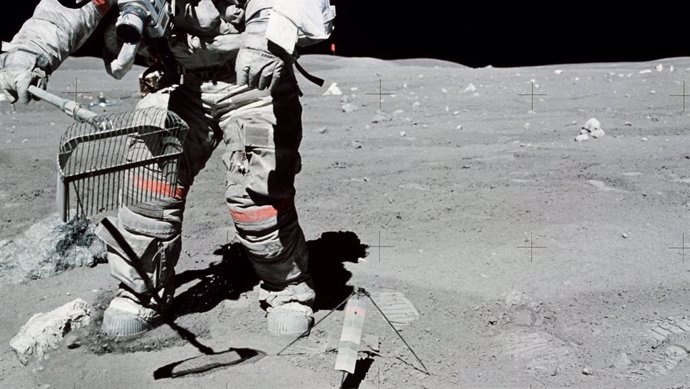Astronaut John W. Young collects samples of lunar regolith. -NASA
Oct. 21 () –
Samples collected from the surface of the Moon by the Apollo 16 crew more than 50 years ago have helped today’s scientists reconstruct billions of years of lunar history.
The research team’s findings, published in the journal Meteoritics & Planetary Scienceare based on the analysis of a distinct set of lunar breccia that have never before been examined in detail.
Astronauts John Young, Charles Duke and Ken Mattingly brought more than 95 kg of Moon samples to Earth after their mission to the Descartes Highlands on the Moon in 1972.
Among those samples were “regolith gaps”, which are formed when lunar dust (or regolith) is fused into rock by asteroid impacts. Once fused into a rock, these breccias preserve the geochemical composition of the regolith at the time of their formation, which can be carefully analyzed for clues about how and when they were created.
The Moon’s distinctive crater-ridden appearance is the result of countless collisions with asteroids since its formation some 4.5 billion years ago. In such a long story, the question of what happened and when it happened quickly becomes complicated.
SUBJECTED TO MASS SPECTROMETRY
The researchers, from the United Kingdom and the United States, used sophisticated analytical mass spectrometry techniques to analyze the composition of gases trapped in samples of smaller fragments, known as soil-like breccia. These samples, which were among those that the Apollo 16 crew raked from the surface of the Moon, They had never before been subjected to mass spectrometry.
The research could also help future manned lunar missions identify valuable natural resources to help make lunar bases self-sufficient.
Previous research had analyzed traces of noble gases within larger fragments of the Apollo 16 gap samples, which helped researchers separate the samples into two groups: “ancient,” aged between 3.8 and 2.4 billion of years, and “young”, that were formed between 2,500 and 1,700 million years ago.
NASA provided researchers with 11 lunar samples for analysis. Nine of the samples revealed a wide range of exposure ages, from 2.5 billion years ago to less than 1 billion years ago. This suggests that they are formed by lunar soil from an area that has had a varied history of impacts, where some were exposed to the solar wind for billions of years.while others were brought to the surface by more recent impacts.
The team also found that two of the samples had much lower concentrations of noble gases, suggesting that they formed much more recently and were perhaps exposed to the solar wind for less than a million years. The team suggests that the impact that formed the nearby South Ray crater could have been the source of that sample.
University of Nottingham scientist Mark Nottingham, lead author of the study, said in a statement: “This study establishes for the first time that soil-like breccias are a category of their own, with their own stories to share. Combined with the analysis of the ancient and young rocks recovered by Apollo 16, we can build a much more complete picture of the history of this part of the moon during the early solar system, where the strongest impacts on the lunar surface in its first billion years or so gave way to less intense periods starting approximately 2 billion years ago.
The research could also help inform ongoing efforts to send future missions to the moon in the near future, such as NASA’s Artemis program, which plans to establish long-term human lunar habitats.





![[Img #74661]](https://thelatestnews.world/wp-content/uploads/2024/12/The-power-of-ultrasound-150x150.jpg)







![[Img #74661]](https://thelatestnews.world/wp-content/uploads/2024/12/The-power-of-ultrasound-300x200.jpg)


Add Comment